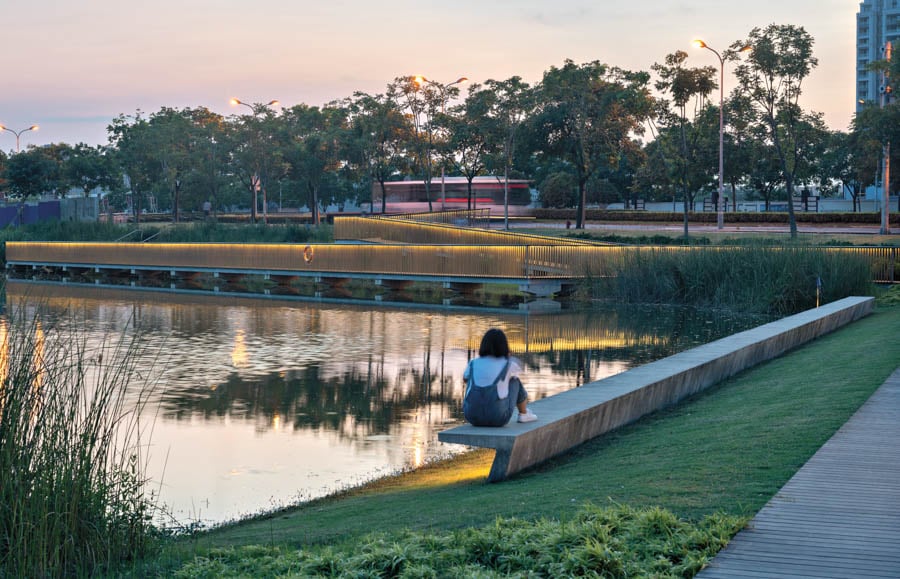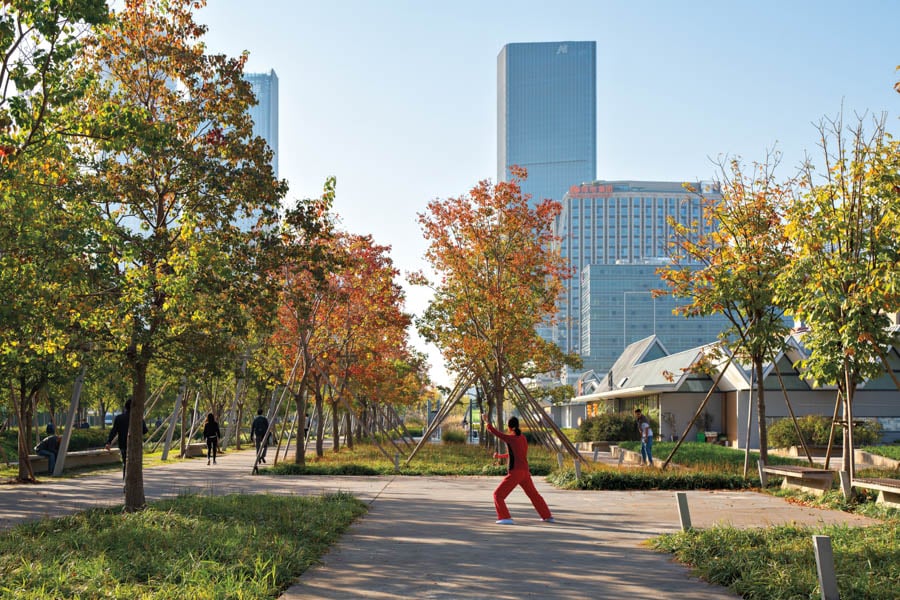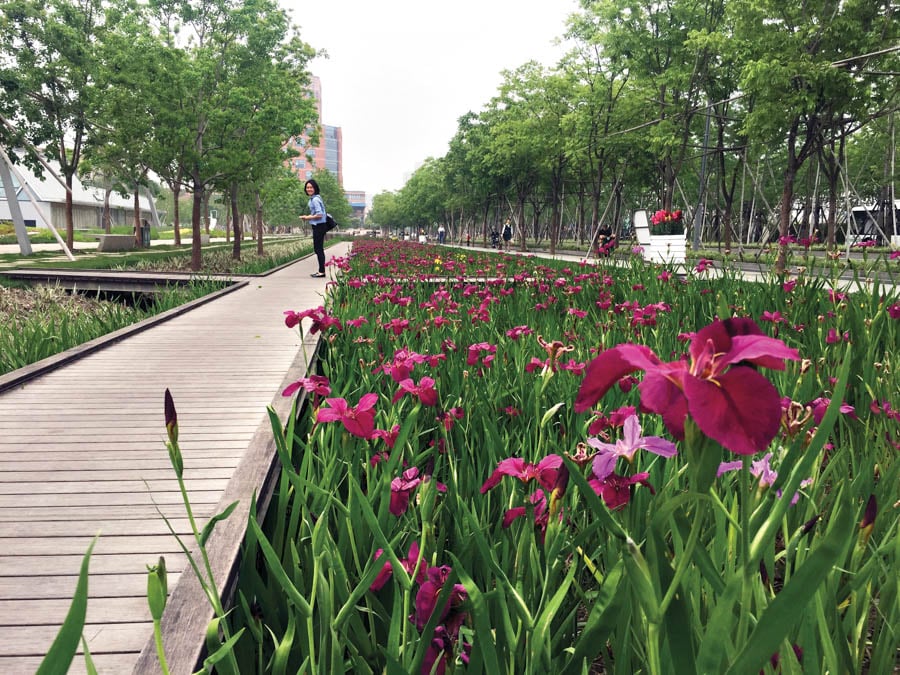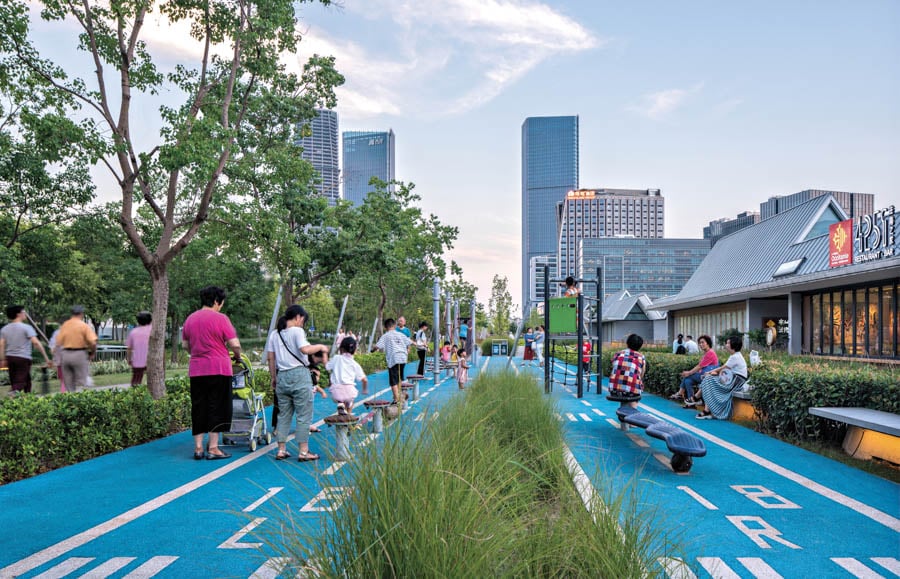
November 30, 2020
Shanghai’s Longhua Airport Is Converted into a New Public Park
Sasaki harnesses the linearity of a disused riverfront airport to create a new sustainable park.

At Xuhui Runway Park on the banks of Shanghai’s Huangpu River, in the middle of one of the largest cities in the world, it’s impossible to miss the history of what came before.
Designed by Sasaki, Xuhui offers a palimpsest of a reused airport, preserving its materials and forms. The 36-acre space is an intensely “linear composition,” says Dou Zhang, senior associate director of Sasaki’s Shanghai office. A concise incision of green space that stops just short of the river, it adopts the long rectangle as its fundamental geometric unit—an adaptation of the former runway—repeated at scales large and small.
Inground lights outline the reused 11-foot concrete airstrip panels, providing a visual connection to the site’s past life and making the former 2,001-yard-long, 87-yard-wide tarmac unmistakable. Original direction-marker supergraphics are preserved, and damaged sections of the landing strip became cobblestone patterns along pedestrian paths. “Because it was an airport runway, we felt [that] the sense of movement was very critical to that space,” says Mark Dawson, a principal in Sasaki’s Boston office. He calls the runway “an amazing datum that collides through the landscape.”

Starting from a daunting imperial axis, the landscape architects had to make sure their design cut the “original scale down to miscellaneous linear spaces,” says Zhang. The park does this with linear circulation routes that echo the form of the park itself with a seven-lane road as well as bike and pedestrian paths. These pathways are separated by planted allées, including the Trident Maple, a signature tree in the park, selected because of its colorful fall foliage, generous canopy, acclimation to Shanghai, and tricornered, aeronautical-shaped leaves. Topographic rises break up the monotony of the park and visually edit out scaleless, flat expanses. And there’s a diverse array of programs and ecologies across the site: a wetland boardwalk, a lawn, a bird-watching grove, a butterfly garden, and a sunken garden that doubles as an events venue.
This green notch in the city is just as jarring to the surrounding urban fabric as the original swipe of gray concrete runway had been in midcentury Shanghai. Longhua Airport operated for 80 years until 2011 and was the city’s only civilian airport till 1949. And while the new park is generated from this same anthropogenic intervention, it works within the local ecology: It’s host to a complex rain garden and canal system that retains and filters stormwater and is filled with plants native to the nearby Yangtze River Delta.

To the park’s north, a boardwalk made of bamboo traipses over a nearly 6,000-square-foot rain garden, surrounded by water-loving hostas, irises, and more. Any water that lands on the walkway is channeled to inlets that bring it onto the hydric soil of the rain garden, where it’s filtered and fed into a perforated pipe system. From here, some of the treated runoff is guided into a cistern, while the rest drains into the municipal stormwater system.
In the southern section of the park, a canal traversed by boardwalks and bridges collects rainfall and water from a smaller forebay channel, where sediment accumulates. Wetland reeds and irises add texture, but the marshy edges are somehow still as exacting as the axial concrete paths that define the site. “The limited dimensions we have to work with are the main reason we have that cleaner edge,” says Zhang. These canals replicate some of the charm and intimacy of traditional Chinese water towns, where ancient stone bridges arc over rowboats.

Xuhui is one of the most progressive manifestations of the Chinese “sponge city” initiative, which seeks to retrofit cities to better absorb stormwater and combat flooding amid rapid urbanization. The runway park got started before the sponge city edict came down in 2015, and all its water retention elements originally seemed like a risk to the client (the Shanghai Xuhui Waterfront Development Investment Construction Company). “Without the sponge city policy, all of those items were pushed back by the client,” says Zhang. But when intensive stormwater management became national land-use policy, the rain garden and canals became something the client actively promoted. The park even became the first landscape in mainland China to earn SITES Gold certification, a LEED-like rating system that recognizes landscapes for their ability to perform beneficial ecosystem services (like stormwater retention and soil remediation).
Zhang says the broader idea of landscape adaptive reuse is well understood in China, as many historic landscapes central to the nation’s identity have transitioned to public parks. The Summer Palace near Beijing, for example, was converted into a park in 1924. But what’s relatively new is the curated presentation of more recent “industrial relics,” Zhang says, outside of China’s historical canon. As China rockets through its industrial phase toward a more service-based economy, the potential of such sites for redevelopment will take off, alongside the need to use the built environment to embed and explain these narratives.
You may also enjoy “Ford Unveils Details of its Plans for Detroit’s Corktown”
Would you like to comment on this article? Send your thoughts to: [email protected]
Register here for Metropolis’s Think Tank Thursdays and hear what leading firms across North America are thinking and working on today.










